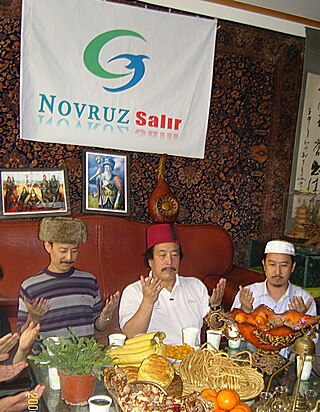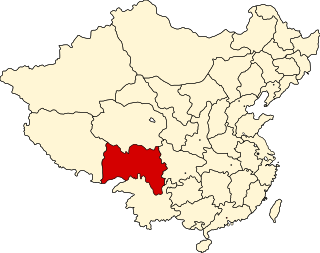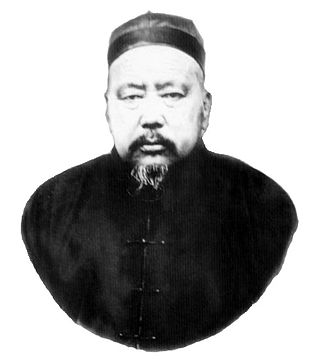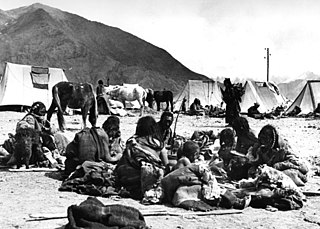
Qinghai is an inland province in Northwestern China. It is the largest province of China by area and has the third smallest population. Its capital and largest city is Xining.

The Salar people are a Turkic ethnic minority in China who speak Salar, a Turkic language of the Oghuz sub-branch. They numbered 165,159 people in 2020, according to that year's national census.

Amdo is one of the three traditional Tibetan regions, the others being U-Tsang in the west and Kham in the east. Ngari in the north-west was incorporated into Ü-Tsang. Amdo is also the birthplace of the 14th Dalai Lama. Amdo encompasses a large area from the Machu to the Drichu (Yangtze). Amdo is mostly coterminous with China's present-day Qinghai province, but also includes small portions of Sichuan and Gansu provinces.
The foreign relations of Tibet are documented from the 7th century onward, when Buddhism was introduced by missionaries from India and Nepal. The Tibetan Empire fought with the Tang dynasty for control over territory dozens of times, despite peace marriage twice. Tibet was conquered by the Mongol Empire and that changed its internal system of government, introducing the Dalai Lamas, as well as subjecting Tibet to political rule under the Yuan dynasty. Tibetan foreign relations during the Ming dynasty are opaque, with Tibet being either a tributary state or under full Chinese sovereignty. But by the 18th century, the Qing dynasty indisputably made Tibet a subject. In the early 20th century, after a successful invasion, Britain established a trading relationship with Tibet and was permitted limited diplomatic access to "Outer Tibet", basically Shigatse and Lhasa. Britain supported Tibetan autonomy under the 13th Dalai Lama but did not contest Chinese suzerainty; while "Inner Tibet", areas such as Amdo and Kham with mixed Chinese and Tibetan populations to the east and north, remained nominally under the control of the Republic of China although that control was seldom effective. Although the sovereignty of Tibet was unrecognized, Tibet was courted in unofficial visits from Nazi Germany, Imperial Japan, and the United States during and after World War II. The foreign relations of Tibet ended with the Seventeen Point Agreement that formalized Chinese sovereignty over most all of political Tibet in 1951.

Kham is one of the three traditional Tibetan regions, the others being Amdo in the northeast, and Ü-Tsang in central Tibet. The original residents of Kham are called Khampas, and were governed locally by chieftains and monasteries. Kham presently covers a land area distributed between five regions in China, most of it in Tibet Autonomous Region and Sichuan, with smaller portions located within Qinghai, Gansu and Yunnan provinces.

Xikang was a nominal province formed by the Republic of China in 1939 on the initiative of prominent Sichuan warlord Liu Wenhui and retained by the early People's Republic of China. The former territory of Xikang is now divided between the Tibet Autonomous Region and Sichuan province.

Labrang Monastery is one of the six great monasteries of the Gelug school of Tibetan Buddhism. Its formal name is Genden Shédrup Dargyé Trashi Gyésu khyilwé Ling.
The Ma clique or Ma family warlords is a collective name for a group of Hui warlords in Northwestern China who ruled the Chinese provinces of Qinghai, Gansu and Ningxia for 10 years from 1919 until 1928. Following the collapse of the Qing dynasty in 1912, the region came under Chinese Muslim warlord Ma Qi's control until the Northern Expedition by the Republic of China consolidated central control in 1928. There were three families in the Ma clique, each of them respectively controlled, parts of Gansu, Ningxia and Qinghai. The three most prominent members of the clique were Ma Bufang, Ma Hongkui, and Ma Hongbin, collectively known as the Xibei San Ma. Some contemporary accounts, such as Edgar Snow's, described the clique as the "Four Ma", adding Ma Bufang's brother Ma Buqing to the list of the top warlords. Other prominent Ma's included Ma Anliang, Ma Qi, Ma Lin, Ma Hu-shan, and Ma Zhongying.

Ma Bufang (1903 – 31 July 1975) (traditional Chinese: 馬步芳; simplified Chinese: 马步芳; pinyin: Mǎ Bùfāng; Wade–Giles: Ma3 Pu4-fang1, Xiao'erjing: مَا بُفَانْ) was a prominent Muslim Ma clique warlord in China during the Republic of China era, ruling the province of Qinghai. His rank was lieutenant-general.

Ma Qi was a Chinese Muslim General in early 20th-century China.

Kumbum Monastery, also called Ta'er Temple, is a Tibetan gompa in Lusar, Huangzhong County, Xining, Qinghai, China. It was founded in 1583 in a narrow valley close to the village of Lusar in the historical Tibetan region of Amdo. Its superior monastery is Drepung Monastery, immediately to the west of Lhasa. It is ranked in importance as second only to Lhasa.

Tibet was a country in East Asia that lasted from the collapse of the Manchu-led Qing dynasty in 1912 until its annexation by the People's Republic of China in 1951.

The Golok or Ngolok peoples live in Golog Tibetan Autonomous Prefecture, Qinghai, China around the upper reaches of the Yellow River and the sacred mountain Amne Machin. The Golok were renowned in both Tibet and China as ferocious fighters free from Tibetan and Chinese control.

The Sino-Tibetan War, or Second Sino-Tibetan War, was a war that began in May and June 1930 when the Tibetan Army under the 13th Dalai Lama invaded the Chinese-administered eastern Kham region, and the Yushu region in Qinghai, in a struggle over control and corvée labor in Dajin Monastery. The Tibetan Army, with support of the British, easily defeated the Sichuan army, which was focused on internal fights. Ma clique warlord Ma Bufang secretly sent a telegram to Sichuan warlord Liu Wenhui and the leader of the Republic of China, Chiang Kai-shek, suggesting a joint attack on the Tibetan forces. The Republic of China then defeated the Tibetan armies and recaptured its lost territory.
The Qinghai–Tibet War or the Tsinghai–Tibet War was a conflict that took place during the Sino-Tibetan War. A rebellion led by the Dalai Lama with British support wanted to expand the original conflict taking place between the Tibetan Army and Liu Wenhui in Xikang, to attack Qinghai, a region northeast of Tibet. Using a dispute over a monastery in Yushu in Qinghai as an excuse in 1932, the Tibetan army attacked. Qinghai Muslim General Ma Bufang overran the Tibetan armies and recaptured several counties in Xikang province. Shiqu, Dege and other counties were seized from the Tibetans. The war against the Tibetan army was led by the Muslim General Ma Biao. The Tibetans were pushed back to the other side of the Jinsha river. The Qinghai army recaptured counties that had been controlled by the Tibetan army since 1919. The victory on the part of the Qinghai army threatened the supply lines to Tibetan forces in Garze and Xinlong. As a result, this part of the Tibetan army was forced to withdraw. Ma and Liu warned Tibetan officials not to dare cross the Jinsha river again. By August the Tibetans lost so much territory to Liu Wenhui and Ma Bufang's forces that the Dalai Lama telegraphed the British government of India for assistance. British pressure led China to declare a cease-fire. Separate truces were signed by Ma and Liu with the Tibetans in 1933, ending the fighting. The British had backed up the Tibetans during the war. After their war the victory over the Tibetans was celebrated by Xikang and Qinghai soldiers.

The Kuomintang Islamic insurgency was a continuation of the Chinese Civil War by Chinese Muslim Kuomintang Republic of China Army forces mainly in Northwest China, in the provinces of Gansu, Qinghai, Ningxia, and Xinjiang, and another insurgency in Yunnan.
The Muslim Conflict in Gansu broke out when a coalition of Muslim generals revolted against the Guominjun in 1927. Prominent among the rebels was Ma Tingxiang, the son of the General Ma Anliang, who received aid in the form of arms from Zhang Zuolin in Manchuria.

Ma Biao (1885–1948) was a Chinese Muslim Ma Clique General in the National Revolutionary Army, and served under Ma Bufang, the Governor of Qinghai. He was a member of Ma Bufang's family, Ma Biao was the eldest son of Ma Haiqing 馬海清, who was the sixth younger brother of Ma Haiyan, the grandfather of Ma Bufang.
The Ninghai Army, later the 26th Division (National Revolutionary Army) was a Muslim Hui army of the Republic of China commanded by General Ma Qi, who controlled the Xining area of Qinghai, then a special region of Gansu province. It was founded by Ma Qi in 1915.

Chinese Muslims in the Second Sino-Japanese War were courted by both Chinese and Japanese generals but they tended to fight against the Japanese with or without the support of higher echelons of the other Chinese factions.














